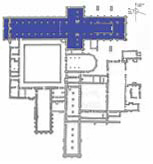 |
 |
 |
 |
 |
 |
 |
|
The Church
Good wine should be strong, like the building
of a Cistercian monastery. The church stood at the heart of Cistercian
life and brought together communal worship, private prayer, ceremony
and ritual. The building
dominated the precinct physically and also structured the monks’ day,
for the community visited the church at least eight times daily
to celebrate the Canonical
Hours. The Romanesque church at Rievaulx
was one of the first of the abbey buildings to be constructed in
stone, and the nave and transepts date from Aelred’s abbacy
in the mid-twelfth century. This church replaced a smaller and
simpler one which had served Abbot
William and the first community
of monks. There are now no traces of William’s church, but
its location is known from geophysical survey conducted in 1996.(1) |
 (1/8)
(1/8)